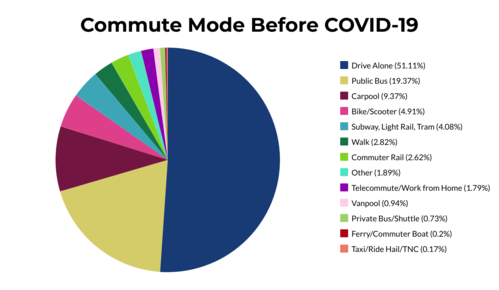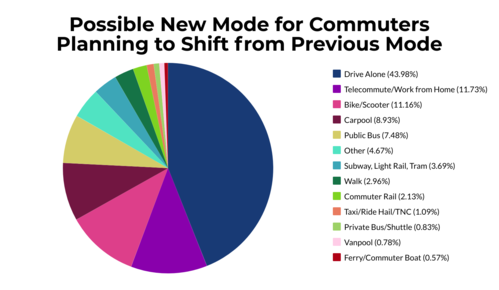The Association for Commuter Transportation (ACT) in partnership with the Center for TDM, developed and distributed a national survey collecting data on the impacts of the COVID-19 pandemic on commuting in the United States. With the help from ACT members, we collected over 10,000 responses from across the country with 78% of respondents currently working full-time. As we continue to analyze this data, we will release a more comprehensive report in the near future. Data will also be presented during a live discussion group at the Virtual International Conference. In the meantime, we wanted to share a few highlights.
Before the Pandemic
Before COVID-19, 51% of respondents reported driving alone, less than 2% reported telecommuting, and less than 5% reported biking as their main commute mode. While 51% drive alone is significantly lower than the national average, this means the survey captures a good amount of data from commuters utilizing public transit and other sustainable modes like carpooling and biking. About 19% reported commuting by public bus before the pandemic and 9% commuted by carpool.
Returning to Worksites
When asked if they plan to use a different mode of commuting when it’s time to return to their workplace, 22% of respondents say they either plan to use a different mode or don’t know yet. When asked to share the top three reasons for that answer, the top 4 reasons for either choosing a different mode or being undecided were:
-
Concern about crowds
-
Concern about sharing spaces with strangers
-
Concern about the ability to clean/sanitize/disinfect appropriately
-
My employer is allowing me to continue working from home
While most commuters plan to resume using their previous mode, we know that even a small percentage change to driving alone can have a significant impact on congestion and air quality. When asked specifically which modes might be (or is) their primary commute mode when returning to the workplace, 44% responded with drive alone, 12% plan to telecommute, and 11% plan to bike (or scooter). TDM professionals, commuter programs, and local agencies will need to identify ways to address the concerns of commuters to ensure that our transportation systems are safe and accessible for commuters to prevent any long-term increases in the drive alone rate.
ACT would like to thank everyone who help in developing this survey and for sharing it amongst your communities, which allowed us to gather 10, 205 responses from all across the United States. We look forward to sharing more results with you soon.



